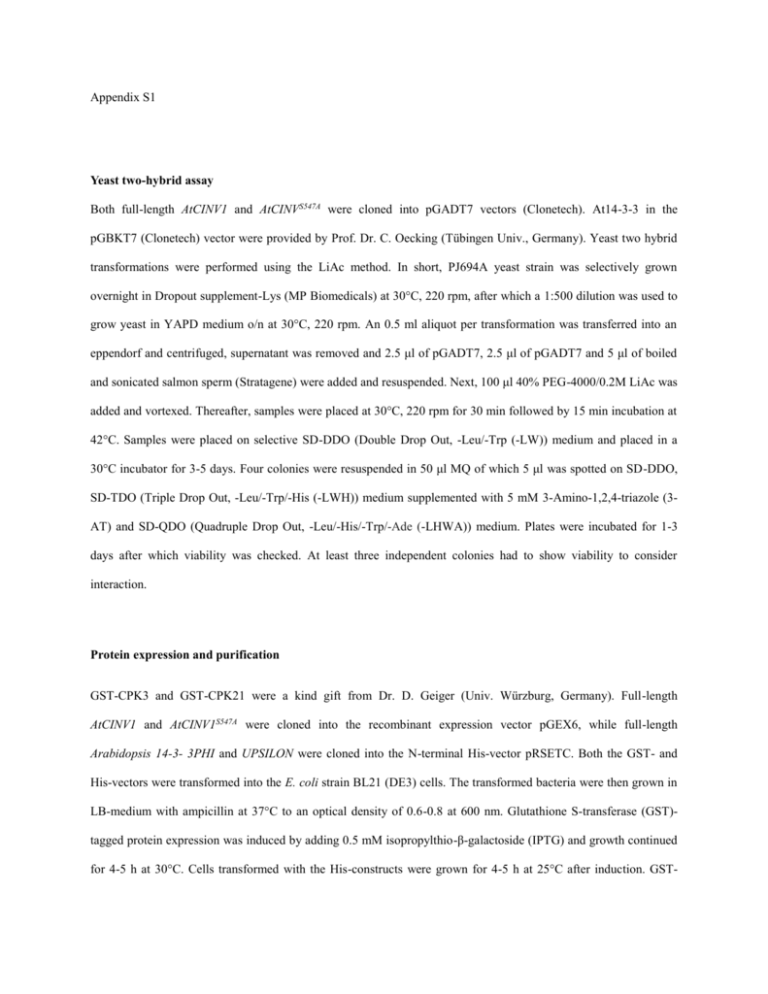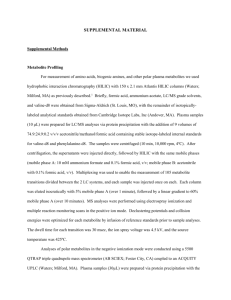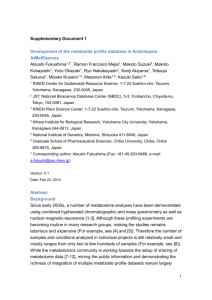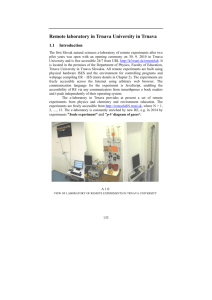tpj12677-sup-0005-AppendixS1
advertisement

Appendix S1 Yeast two-hybrid assay Both full-length AtCINV1 and AtCINVS547A were cloned into pGADT7 vectors (Clonetech). At14-3-3 in the pGBKT7 (Clonetech) vector were provided by Prof. Dr. C. Oecking (Tübingen Univ., Germany). Yeast two hybrid transformations were performed using the LiAc method. In short, PJ694A yeast strain was selectively grown overnight in Dropout supplement-Lys (MP Biomedicals) at 30°C, 220 rpm, after which a 1:500 dilution was used to grow yeast in YAPD medium o/n at 30°C, 220 rpm. An 0.5 ml aliquot per transformation was transferred into an eppendorf and centrifuged, supernatant was removed and 2.5 μl of pGADT7, 2.5 μl of pGADT7 and 5 μl of boiled and sonicated salmon sperm (Stratagene) were added and resuspended. Next, 100 μl 40% PEG-4000/0.2M LiAc was added and vortexed. Thereafter, samples were placed at 30°C, 220 rpm for 30 min followed by 15 min incubation at 42°C. Samples were placed on selective SD-DDO (Double Drop Out, -Leu/-Trp (-LW)) medium and placed in a 30°C incubator for 3-5 days. Four colonies were resuspended in 50 μl MQ of which 5 μl was spotted on SD-DDO, SD-TDO (Triple Drop Out, -Leu/-Trp/-His (-LWH)) medium supplemented with 5 mM 3-Amino-1,2,4-triazole (3AT) and SD-QDO (Quadruple Drop Out, -Leu/-His/-Trp/-Ade (-LHWA)) medium. Plates were incubated for 1-3 days after which viability was checked. At least three independent colonies had to show viability to consider interaction. Protein expression and purification GST-CPK3 and GST-CPK21 were a kind gift from Dr. D. Geiger (Univ. Würzburg, Germany). Full-length AtCINV1 and AtCINV1S547A were cloned into the recombinant expression vector pGEX6, while full-length Arabidopsis 14-3- 3PHI and UPSILON were cloned into the N-terminal His-vector pRSETC. Both the GST- and His-vectors were transformed into the E. coli strain BL21 (DE3) cells. The transformed bacteria were then grown in LB-medium with ampicillin at 37°C to an optical density of 0.6-0.8 at 600 nm. Glutathione S-transferase (GST)tagged protein expression was induced by adding 0.5 mM isopropylthio-β-galactoside (IPTG) and growth continued for 4-5 h at 30°C. Cells transformed with the His-constructs were grown for 4-5 h at 25°C after induction. GST- protein containing cells were harvested and crushed by French Press in 30 ml of phosphate-buffered saline (PBS) containing 1× protease inhibitor cocktail (Roche). GST-fusion proteins were subjected to column purification at room temperature (RT) using glutathione sepharose (GSTrap™ FF columns, 1 ml, GE Healthcare). 50 mM Tris-HCl with 10 mM reduced glutathione was used for protein elution, then protein containing fractions were pooled and desalted with 50 mM HEPES; pH 8.0. Cells expressing the His-tagged proteins were harvested and lysed by French Press in 30 ml of binding/wash buffer (300 mM NaCl, 50 mM sodium phosphate, 10 mM imidazole, 1× protease inhibitor cocktail (Roche); pH 7.4). Lysates were centrifuged and the His-fusion protein was bound to Nickel sepharose (HisTrap™ HP columns, 1 ml, GE Healthcare). The His-tagged protein was eluted with 300 mM imidazole in binding/wash buffer. Protein containing fractions were pooled and desalted with 50 mM HEPES (pH 8.0). Protein concentrations were determined by Bradford micro-assay (Bio-Rad) using BSA as a standard. Metabolomics of 14-3-3 quadruple mutants and wild-type plants Plants were grown in ½ strength Hoagland solution (3 mM KNO 3, 2 mM Ca(NO3)2, 1 mM NH4(H2PO4), 0.5 mM MgSO4, 20 μM Fe-EDTA, 1 μM KCl, 25 μM H3BO3, 2 μM MnSO4, 2 μM ZnSO4, 0.1 μM CuSO4, 0.1 μM (NH4)6Mo7O24) in a growth chamber at 14/10 h day/night regime, 22/18°C day/night temperature and a photon flux density of 170 μmol.m-2.s-1. Fully developed roots of 22 day-old plants were harvested for metabolite extraction. Metabolite profiling by GC-time of flight (TOF)-MS was performed as described previously (Lisec, Schauer et al. 2006, Erban, Schauer et al. 2007). Around 50 mg of frozen ground material was homogenized in 300 μl of methanol at 70°C for 15 min and then 200 μl of chloroform at 37°C for 5 min. The polar fraction was prepared by liquid partitioning into 400 μl of water. The polar fraction was derivatized by methoxyamination and subsequent trimethylsilylation. Samples were analyzed using GC-TOF-MS (ChromaTOF software, Pegasus driver 1.61; LECO). The chromatograms and mass spectra were evaluated using TagFinder software (Luedemann, Strassburg et al. 2008) and NIST05 software (http://www.nist.gov/srd/mslist.cfm). Metabolite identification was manually supervised using the mass spectral and retention index collection of the Golm Metabolome Database (Kopka, Schauer et al. 2005, Hummel, Pantin et al. 2010, Hummel, Strehmel et al. 2010). Peak heights of the mass fragments were normalized on the basis of the fresh weight of the sample and the added amount of an internal standard ([13C6]-sorbitol) (Watanabe, Balazadeh et al. 2013). Mass-spectrometry of proteins in 14-3-3 pull-down Proteins from pull-down experiments were resolved on a one-dimensional 10% SDS polyacrylamide gel. After staining with Coomassie Blue, each sample lane was divided into four pieces. Each gel slice was cut into small particles and transferred to a clean micro-centrifuge tube. For in-gel digestion, 50% acetonitrile containing 50 mM (NH4)HCO3 was added and vortexed until the Coomassie brilliant blue was completely removed. To reduce the cysteine residues, each gel band was covered with a 10 mM DTT solution prepared in 50 mM (NH 4)HCO3 for 60 min at 56 °C. The DTT solution was removed, and the excised bands were incubated with 55 mM iodoacetamide prepared in 50 mM (NH4)HCO3 for 40 min in the dark. The iodoacetamide solution was then removed. After washing the gel particles three times with 50 mM (NH4)HCO3 for 10 min, dehydration was performed with 100% acetonitrile for 10 min. The gel particles were then vacuum-dried for 20 min and rehydrated with 12.5 μg/μL trypsin (Promega) in 50 mM (NH4)HCO3 buffer. Digestion was performed by incubation at 37 °C overnight. Following digestion, tryptic peptides were extracted with 100 μl of 50% acetonitrile/1% acetic acid for 20 min. The tryptic peptides were dried with speed-vac, re-dissolved in 40 μl 0.1% acetic acid and subjected to LC-MS/MS analysis as described by Chen et al. (Chen, Van der Schors et al. 2011). MS/MS spectra were searched against an IPI Arabidopsis database (ipi.ARATH.v3.85) with the ProteinPilotTM software (version 3.0; Applied Biosystems, Foster City, CA, USA; MDS Sciex) using the Paragon algorithm (version 3.0.0.0) as the search engine. The search parameters were set to cysteine alkyation with acrylamide, and digestion with trypsin. In this experiment, we included the “unused” values generated from the software ProteinPilot as a semi-quantitative means for relative comparison (Klemmer, Smit et al. 2009). The ‘unused’ value is defined as a summation of protein scores from all the nonredundant peptides matched to a single protein. Peptides with confidence of > 99 have a protein score of 2; > 95 have a protein score of 1.3, > 66 have a protein score of 0.47, etc. Chen, N., R. C. Van der Schors and A. B. Smit (2011). "A1D-PAGE/LC-ESI linear ion trap Orbitrap MS approach." In: Neuroproteomics; Neuromethods. K.W. Li (Ed.): 159-168. Erban, A., N. Schauer, A. R. Fernie and J. Kopka (2007). "Nonsupervised construction and application of mass spectral and retention time index libraries from time-of-flight gas chromatography-mass spectrometry metabolite profiles." Methods in molecular biology (Clifton, N.J.) 358: 19-38. Hummel, I., F. Pantin, R. Sulpice, M. Piques, G. Rolland, M. Dauzat, A. Christophe, M. Pervent, M. Bouteille, M. Stitt, Y. Gibon and B. Muller (2010). "Arabidopsis Plants Acclimate to Water Deficit at Low Cost through Changes of Carbon Usage: An Integrated Perspective Using Growth, Metabolite, Enzyme, and Gene Expression Analysis." Plant Physiology 154(1): 357-372. Hummel, J., N. Strehmel, J. Selbig, D. Walther and J. Kopka (2010). "Decision tree supported substructure prediction of metabolites from GC-MS profiles." Metabolomics 6(2): 322-333. Klemmer, P., A. B. Smit and K. W. Li (2009). "Proteomics analyses of immuno-precipitated synaptic protein complexes." Journal of Proteomics 72(1): 82-90. Kopka, J., N. Schauer, S. Krueger, C. Birkemeyer, B. Usadel, E. Bergmuller, P. Dormann, W. Weckwerth, Y. Gibon, M. Stitt, L. Willmitzer, A. R. Fernie and D. Steinhauser (2005). "GMD@CSB.DB: the Golm Metabolome Database." Bioinformatics 21(8): 1635-1638. Lisec, J., N. Schauer, J. Kopka, L. Willmitzer and A. R. Fernie (2006). "Gas chromatography mass spectrometry-based metabolite profiling in plants." Nature Protocols 1(1): 387-396. Luedemann, A., K. Strassburg, A. Erban and J. Kopka (2008). "TagFinder for the quantitative analysis of gas chromatography - mass spectrometry (GC-MS)-based metabolite profiling experiments." Bioinformatics 24(5): 732-737. Watanabe, M., S. Balazadeh, T. Tohge, A. Erban, P. Giavalisco, J. Kopka, B. Mueller-Roeber, A. R. Fernie and R. Hoefgen (2013). "Comprehensive Dissection of Spatiotemporal Metabolic Shifts in Primary, Secondary, and Lipid Metabolism during Developmental Senescence in Arabidopsis." Plant Physiology 162(3): 1290-1310.







